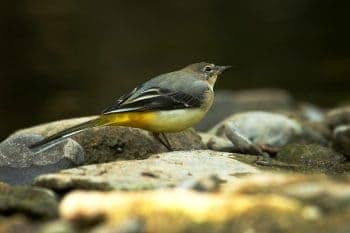The Ultimate Guide to the Grey Wagtail
What is the Grey Wagtail and what do they look like?
Grey Wagtails can be noticed for their slate, blue/grey wings, tail and upper parts. However their underparts are a distinctive and vibrant yellow colour with a black bib, making them instantly recognisable.
The female however does not have a black bib or have such bright yellow underparts. Their tails are longer than that of a Pied Wagtail or a Yellow Wagtail, but they can often be mistaken for a Yellow Wagtail because of their similar colours and markings. As their name suggests, they have a tendency to wag their tail up and down while they walk. Their long tails also improve their agility while flying in pursuit of insects and flies.
Apart from their wagging tails, you may also recognise them by their unique flying technique. They tend to fly low to the ground in a rise and falling motion, bobbing up and down in the air while expressing their loud, chipping calls.

What do Grey Wagtails eat?
Their diet mainly consists of insects, flies and beetles which they tend to fish out of rivers or running streams. However they do consume various different creatures and have been seen feeding on tadpoles or water snails which they catch from the edges of shallow ponds.
Grey Wagtails won’t eat peanuts or sunflower seeds from garden bird feeders since they are not a part of their natural diet, however they may eat
dried mealworms scattered across the lawn or from a
ground bird feeder.
Where does the Grey Wagtail live?
The Grey Wagtail can be found in many places across the UK. They are rarely seen around central and eastern England in the Summertime but are commonly found up in the hills of England, Scotland and Wales. They can be spotted near streams, rivers or any sources of running water. In winter they can be seen in groups flying around farmland, woods, and even towns and city centers. They are rare garden visitor but can be spotted on occasion strolling about the lawns or near garden ponds.

Where do Grey Wagtails nest?
Grey Wagtails begin their breeding process in April. They usually build their nests close to fast flowing rivers up in hollows or in between the small holes and corners among rocks and stones. They have sometimes been seen to nest in old, abandoned buildings and manmade structures too.
They tend to line their nests with moss and hair and lay a clutch of three to six pale grey, speckled eggs. It takes about twelve days for the incubation process to complete and after that another twelve days for the fledgling period, during which time the baby birds will learn how to fly and afterwards go off into the world by themselves.
Do Grey Wagtails Migrate?
Grey Wagtails do not engage in the migration from one place to another, but after the summer they move from upland, northern areas to lowland areas for the winter. This is called altitudinal migration.
Their cousins the
Pied Wagtail however, can migrate to as far south as north Africa to get away from the cold.
What does a Grey Wagtails call sound like?
The grey wagtail has a sharp chipping call that can be heard while they are in flight as they move swiftly across the sky.
Click here to listen


